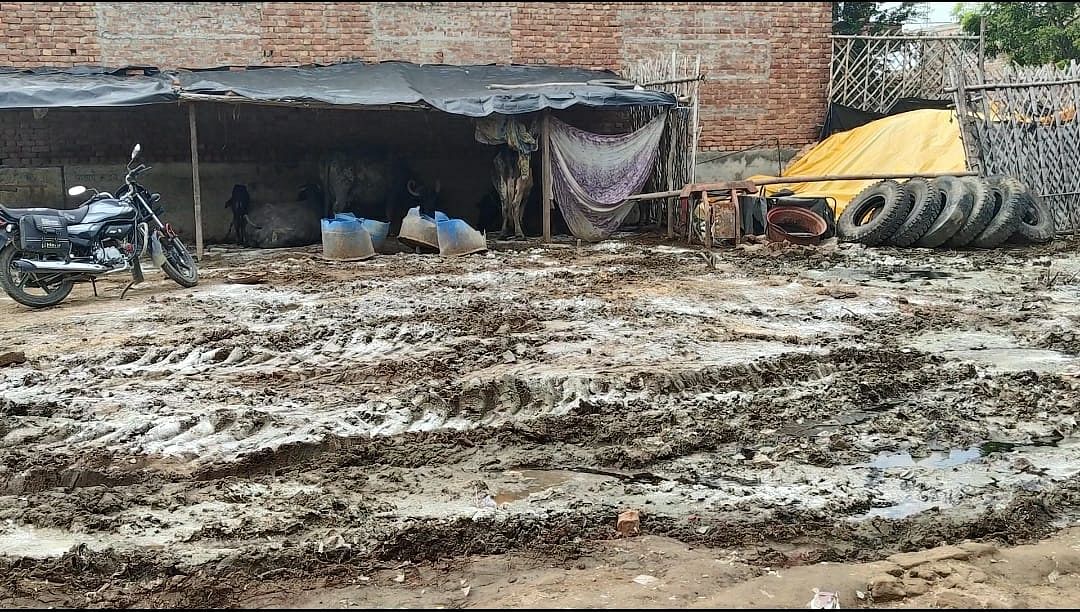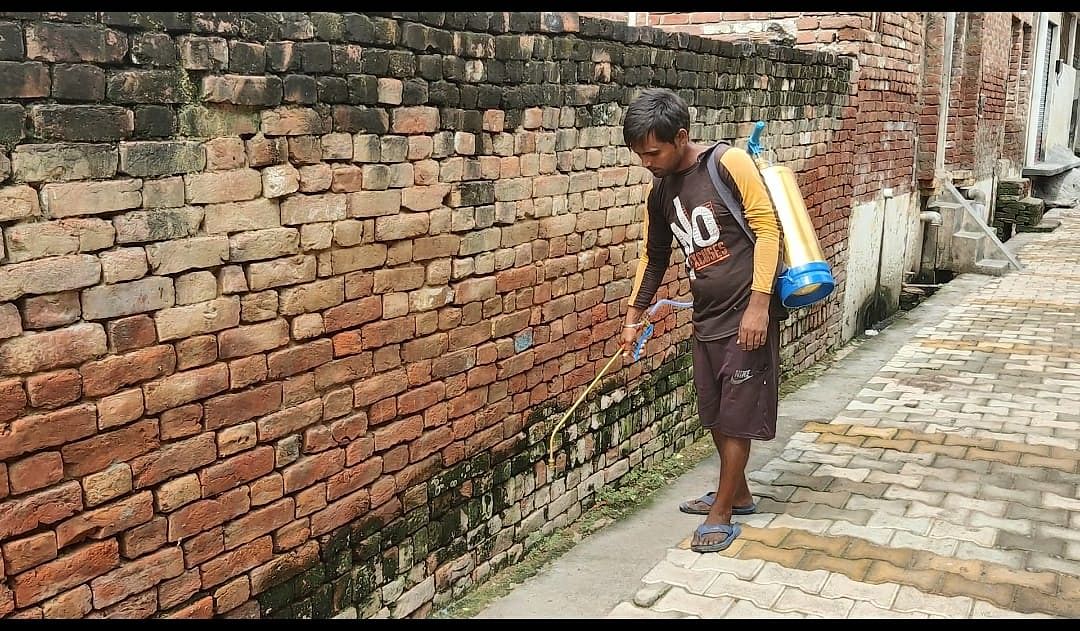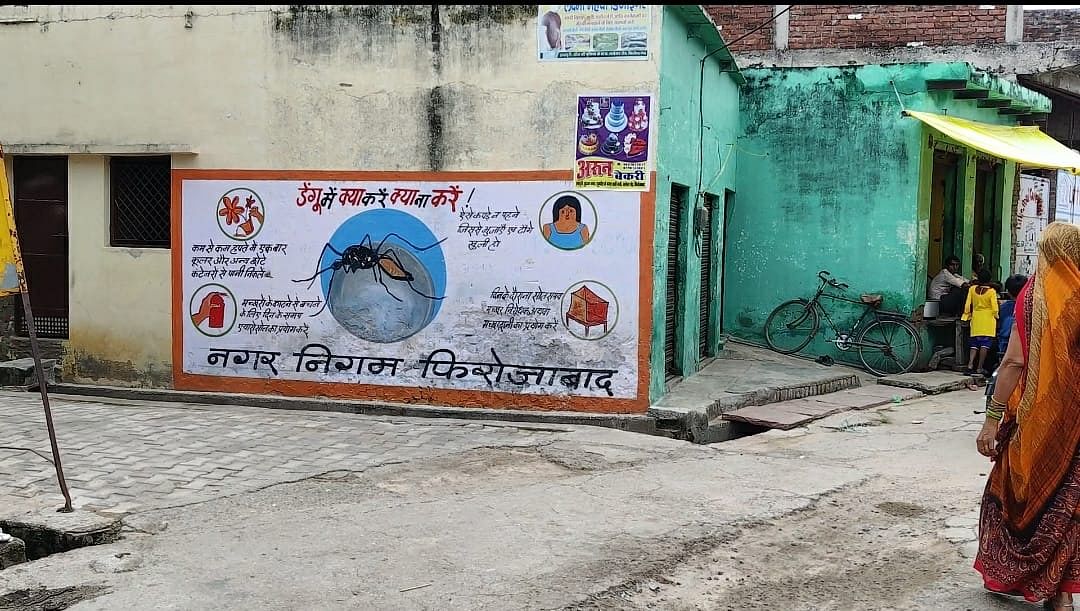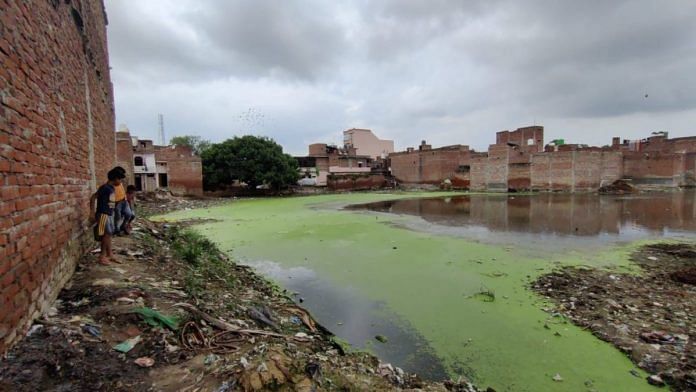Firozabad: On either side of the Rehna naala, an 8-km sewage drain running through Firozabad city, lie slums. A foul smell from the drain permeates the air, and the heavy rains have reduced much of the kutcha roads here to marsh.
Water from the rains has formed ponds on some empty plots of land in the slums, and the boundaries of these water bodies are littered with garbage thrown by local residents. Pigs, cows and crows scavenge through the garbage for food while flies and mosquitoes fly around with abandon.
Garbage and water inundation are common sights around Sudama Nagar, Mahadev Nagar and Thaarputha, three localities in the city visited by ThePrint last week.

Residents of Thaarputha said they alone had lost 10-12 children in the ongoing outbreak of five diseases — dengue, malaria, scrub typhus, leptospirosis and viral fever — that has rattled the district for a month.
Beginning 20 August, when the outbreak was first identified as a “mystery illness” primarily affecting children, there have been 63 deaths, according to the official toll.
Dengue, a vector-borne disease, has been identified by the authorities as the primary driver of the outbreak, which authorities say is now on the ebb. The fact that children appear to be the worst hit has been attributed to the D2 strain of dengue, described by district authorities as “very virulent and more dangerous”.
Dengue is spread by mosquito bites, and prevention advisories focus on protection against exposure to mosquitoes.
The WHO guidelines advise preventing mosquitoes from accessing egg-laying habitats “by environmental management and modification”. These include “disposing of solid waste properly and removing artificial man-made habitats that can hold water, covering, emptying and cleaning of domestic water storage containers on a weekly basis, applying appropriate insecticides to water storage outdoor containers”.
In conversations with residents and the authorities, alleged violations of these guidelines were repeatedly cited to explain the outbreak, with both sides pointing fingers at each other.
However, the district authorities admit that the shift of the administration’s focus to the Covid pandemic may be partly to blame for setting the stage for the outbreak.
For, according to the central government’s Integrated Disease Surveillance Programme portal — where every district is mandatorily supposed to give updated figures on disease outbreaks every week — the district hasn’t reported an outbreak of any of the 5 diseases over the past three years.
Also Read: In Firozabad, people flee or send kids away as 5 diseases are identified as ‘mystery illness’
‘We want cleanliness’
When ThePrint arrived at Sudama Nagar, one of the most badly affected areas also visited by Chief Minister Yogi Adityanath on 30 August, it saw workers of the municipal corporation cleaning up a plot that had a lot of garbage. There has been a regular clean-up under way over the past 15-20 days, residents said.

However, residents of Mahadev Nagar and Thaarputha claimed they had seen fogging and spraying only once since the outbreak.
“I have never seen even a jhaaduwala (sweeper) in this area, much less anyone with anti-mosquito medicine, and I have been living here for five years,” said 72-year-old Chokhey Laal, a resident of Mahadev Nagar.
“My house is right next to this plot with water, which is so big you may call it a lake. Even after such a severe dengue outbreak, we’re yet to see any action here.”
At Thaarputha, residents were sitting on a hunger strike — underway for four days at the time — when this reporter visited on 24 September. Their demand was cleanliness.
“This is Nagar Nigam Ward 32, and there’s absolutely no development in the area. Kutcha roads have become marshy, water-logging is so bad that a vacant plot at the back of the colony has become a pond and there’s no way for the water to flow out of there,” said resident Vicky Yadav, 25.
“Because of this, dengue has spread in the area. I tell you, at least 10 children are hospitalised, and we’ve lost 10-12 children, but even after so much death and destruction, no action has been taken yet.”
On 25 September, legislator Manish Asija gave them a written assurance that he’ll get the area developed, after which the protesters called off the strike.
Similar issues were reported when ThePrint visited two Firozabad villages — Nagla Amaan and Nagla Mavasi villages — last week.
Apart from the Rehna naala, there is another drain flowing through Firozabad city — Bamba naala — and both carry the city’s sewage with them.
Municipal Commissioner Prerna Sharma said the district treats the water of drains in sewage control plants, and cleans the drains every year before the rainy season, but noted that the public throws plastic waste in the water that accumulates on the edges.
“Since the public is used to throwing plastic material in the drain… it gets accumulated on its banks on a very regular basis. After the outbreak also, we cleaned up the drains and didn’t find silt but floating (plastic and other waste) in it,” she told ThePrint.
The commissioner said the open drains could not be a factor in allowing mosquito breeding since they hold flowing water. On top of it, she said, the district has sprayed the water with BTI (Bacillus thuringiensis subspecies israelensis, a biological or a naturally occurring bacterium found in soils) as an anti-larva solution and also insecticides.
Firozabad Chief Medical Officer Dinesh Kumar Premi said improper water storage by people at homes is also a factor in the outbreak. Most houses in Firozabad receive running water only for an hour every day, because of which people collect and store large quantities of water at home, he added.
“The dengue mosquito lives inside the house. It typically has a 10-day lifespan, and can infect the entire family and breed, which can then infect the entire neighbourhood. In Firozabad urban, people store water in tanks as big as 200 litres, which are often uncovered, where larvae are born and cause infection,” he told ThePrint.
He, however, appeared to admit possible lapses in preventive measures this season for dengue control. According to Premi, “maybe” it was the increased attention to Covid that various nagar palikas in the district failed to clean drains on time or spread awareness about dengue and malaria this monsoon season.
He also pointed out, however, that rains this year have been heavier, sporadic and off-season, saying it has contributed to creating conducive conditions for the outbreak.
Also Read: Firozabad struggles with 5 infections but people prefer ‘jhola-chhap’ quacks over govt hospitals
Control measures underway
Asked about the steps the administration is taking to control the outbreak, Municipal Commissioner Sharma said they’re spraying anti-larva medicine and conducting fogging in the entire city.
The corporation, she added, has also released 25,000 mosquito-eating fish in various ponds throughout the city, and pumped water out from various places.
“The corporation has cleaned 25 plots that had garbage in them since the outbreak and stationed 450 additional personnel in affected areas to carry out a clean-up. The corporation has distributed 25,000 tubes of the Odomos mosquito repellent cream in these areas,” she told ThePrint.

CMO Premi said the medical department is fighting the outbreak through a five-step programme, which includes house-to-house survey and providing treatment to people exhibiting fever symptoms, source reduction, which means cleaning water coolers and other places in the house with stored water, and spraying anti-larva medicine in stored water not meant for drinking.
Premi said they survey 50 houses if even one dengue patient is found in the community, and are also carrying out fogging and anti-larva medicine spraying drives.
(Edited by Sunanda Ranjan)
Also Read: Toilets caked with faeces, rotting food: Free rein for filth at Firozabad hospital amid outbreak



